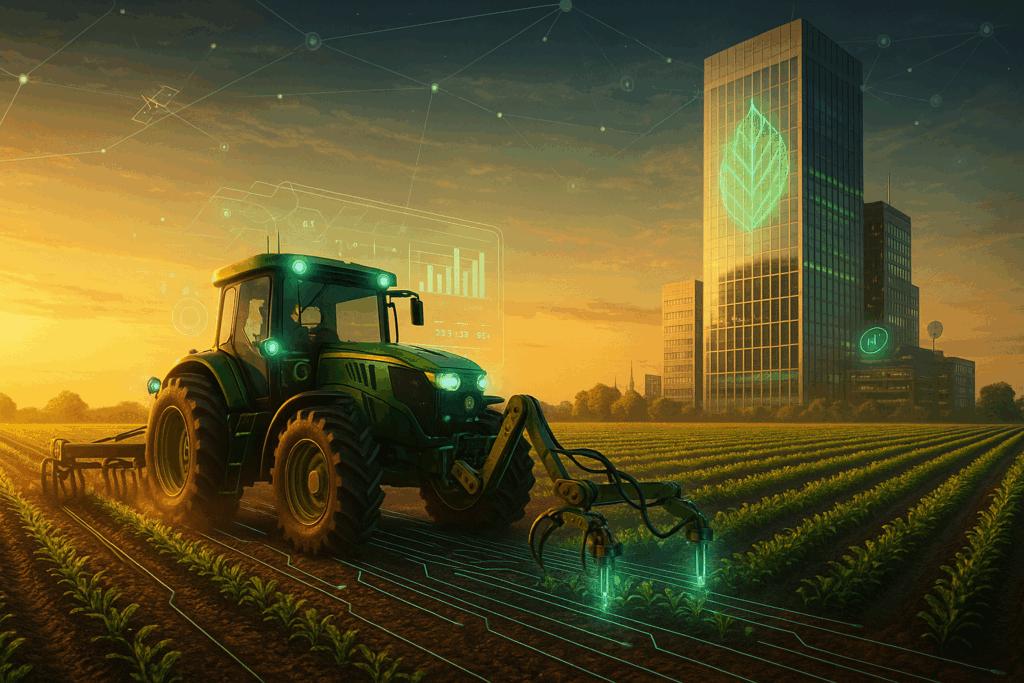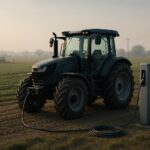The worlds of high finance and high farming are converging in surprising ways. Union Bancaire Privée (UBP), a Swiss private bank known for its impact investing, is promoting precision agriculture – the application of AI and digital technology to farming – as a new alternative asset class for investors. In doing so, UBP is repackaging age-old farmland and cutting-edge agri-tech into a compelling investment narrative, one that promises solid returns alongside environmental and social benefits. This article explores why precision agriculture may be poised to become the next big thing in alternative investments.
Table of Contents
ToggleFarming for Returns: Agriculture as an Asset Class
For many years, farmland itself has been viewed as an “alternative” asset – a tangible, yield-producing investment outside traditional stocks and bonds. Its allure lies in stability and diversification. Take U.S. farmland: real estate investment trusts like Gladstone Land have amassed tens of thousands of acres and enjoyed near-100% occupancy by tenant farmers, translating into steady income and even monthly dividends. Prime agricultural land has historically appreciated in value, especially as climate change and urbanization constrain supply. Investors have noticed that farmland returns often hold up well when equity markets falter, making agriculture a potential hedge.
Yet traditional farming is resource-intensive and subject to commodity price swings. That’s where precision agriculture enters – augmenting the asset class with technology that boosts efficiency and sustainability. By equipping farms with sensors, drones, AI-driven machinery and data analytics, precision ag allows farmers to do more with less. Instead of blanket spraying entire fields with chemicals, farmers can now use “see-and-spray” robots and machine vision to target pests or weeds only where needed. This saves money on inputs, reduces runoff pollution, and can increase yields by optimizing resource use. In effect, technology is enhancing the productivity – and possibly the profitability – of the underlying farmland asset.

The economic case is significant. The global agriculture equipment market, valued at over $180 billion, is growing at 5–7% annually, fueled by rising demand for AI-driven automation and precision farming tools. And McKinsey analysts estimate that better connectivity and digital tools on farms could add a staggering $500 billion to global GDP by 2030. Such numbers suggest that tech-enabled farming isn’t just good for the planet; it could also unlock new economic value. For investors seeking “real” assets with growth potential, these innovations make agriculture more attractive than the sleepy, weather-dependent sector of the past.
UBP’s Biodiversity Bet: Precision Ag in a Portfolio
UBP has been quick to seize this intersection of technology and sustainability. The bank’s Biodiversity Restoration strategy – an Article 9 SFDR fund dedicated to conservation themes – is investing in precision agriculture to drive both returns and restoration outcomes. As portfolio manager Adrien Cambonie notes, with food systems accounting for roughly 30% of global greenhouse emissions, we must “produce more using fewer resources,” and precision farming is key to that mission. UBP’s strategy is primarily invested in listed equities (making it accessible and liquid), but it behaves like an alternative asset by targeting niche themes and impact goals.
Tellingly, two top holdings in the fund are U.S. farm equipment giants that have transformed themselves into ag-tech leaders. John Deere, for instance, uses AI in its “See & Spray” platform that by 2024 had covered one million acres with pinpoint herbicide applications. The result: nearly a 60% reduction in herbicide use on those fields. Such dramatic input savings not only cut farmers’ costs but also reduce environmental damage – a win-win that presumably boosts John Deere’s long-term value. Another holding, AGCO, similarly specializes in precision ag machinery, reflecting the fund’s confidence that these companies can profit from farming’s high-tech evolution.
UBP doesn’t stop at tractors and drones. The fund also backs vertical farming enterprises that grow produce year-round under LED lights with minimal water. One example uses 95% less water than conventional farms by recycling moisture in climate-controlled stacks of greens. Such ventures straddle agriculture and technology in a way that would have sounded like science fiction a generation ago. By investing in them, UBP is effectively treating food technology as part of an alternative assets portfolio – akin to how venture capital might view agritech startups, but through the lens of a public markets fund.
The “alternative” flavor also comes from the impact mandate. The Biodiversity strategy is explicitly designed to channel capital into sustainable land use – conservation, regenerative agriculture, forestry – alongside seeking equity-like returns. It’s a hybrid of traditional investing and mission-driven funding, which appeals to institutional investors in Europe (particularly Scandinavia, the UK, and France) who have reportedly shown strong interest. In fact, despite recent political backlash against ESG investing, UBP’s impact funds have performed well and attracted inflows, growing their AUM from a mere $42 million in 2018 to over $500 million by 2025. This suggests that when presented as a compelling investment thesis (not just a moral choice), sustainable agriculture can draw serious capital.
Technology, Sustainability, and the “Alternate” Story
Framing precision ag as an alternative asset class is as much a narrative strategy as a financial one. UBP and others are effectively telling investors: this isn’t just farming, it’s a high-growth, innovative sector akin to tech or private equity, with the added benefit of tangible assets (land, equipment) underneath. The narrative is bolstered by macro trends that any analyst can appreciate:
- Global Demand and Food Security: With nearly 10 billion people to feed by 2050, we simply need to grow more food, more efficiently. Large-scale farms must adopt organic and regenerative practices to heal soils, but also lean on new tech to maintain yields. Investors see a secular growth story in companies enabling higher crop output with fewer inputs.
- Climate and Resource Constraints: Scarcer water and arable land, plus the drive to cut emissions, favor technologies that squeeze more crop per drop of water or joule of energy. Precision ag does exactly that. For instance, drought-resistant GM seeds and AI irrigation systems address climate volatility – another innovation layer on the asset class that can spur returns while meeting environmental needs.
- Cyclical Hedge and Inflation Protection: Agricultural assets often have low correlation with stock markets and can even benefit from inflation (as food prices and land values rise). In times of uncertainty, alternative investment strategists tout these qualities. UBP’s own research frames such investments as crucial diversifiers that can buffer portfolios in volatile, rising-rate environments.
- Public Policy Tailwinds: Governments and international bodies are incentivizing sustainable farming – from EU green subsidies to U.S. climate-smart agriculture funds. Meanwhile, big agriculture M&A deals (like ChemChina’s $43B takeover of Syngenta or Bayer’s $63B Monsanto acquisition) underscore how strategic and valuable agtech and ag-biotech have become. Policy support and consolidation trends often signal a robust investment theme.
By cataloguing these drivers, UBP places precision ag in the same conversation as more established alternative sectors (think infrastructure or real estate). The bank’s impact report even likens AI in farming to a catalyst for positive outcomes, akin to how tech has revolutionized healthcare and energy. The implicit message: precision ag is part of a broader technological revolution that savvy investors should not miss.
Caution: Cycles and Execution Risk
No investment is a panacea, of course. Agriculture remains cyclical and weather-dependent, tech or not. In bumper crop years with high prices, farmers splurge on AI tractors; in lean years, they tighten belts. This cyclical nature could temper the “all-weather” appeal of precision ag assets. Furthermore, high-tech farming is still in early adoption – many farms globally lag in deploying sensors or autonomous equipment. One could argue that execution risk remains: will these technologies be embraced widely and yield the expected efficiencies?
Investors also face the risk of over-enthusiasm. Agtech venture funding boomed in the late 2010s; some startups failed to live up to promises of disrupting farming. The hype cycle could repeat if unrealistic expectations are set. For example, vertical farms have wowed with sustainability stats (95% less water, etc.), but skeptics note their energy costs and economic viability are still being proven. So while UBP’s strategy invests in vertical farming, it likely does so judiciously alongside more established picks like Deere. The success of treating precision ag as an asset class will depend on picking winners – the companies and projects that truly scale and achieve profitable unit economics, rather than every green-tinted venture that comes along.
Another consideration is liquidity and structure. If one treats farmland itself as an asset, it’s relatively illiquid and long-horizon. UBP’s approach via listed equities and funds provides liquidity but could be more volatile (since stocks respond to short-term market swings even if underlying farmland is stable). Some investors might pursue direct farmland ownership or private funds (TIAA, for instance, has large farmland portfolios) for a pure-play alternative investment. The growth of farmland REITs and funds indicates a rising appetite – a Farm Credit study noted technological transformation (precision ag, AI) “enhancing the appeal—and value—of agricultural assets”. If precision ag truly boosts farm profitability, we may see farmland values appreciate further, delivering real asset gains. That would vindicate the alt-asset thesis.
Harvesting the Future
On balance, the trend is clear: finance is increasingly viewing sustainable agriculture through a Silicon Valley lens – as a source of innovation and alpha, not just a quaint sector dependent on rain and sun. UBP’s repackaging of precision ag as an alt-asset class reflects a broader shift in mindset. The bank’s impact funds are effectively blending philanthropy with profit, aiming for “win-win” outcomes. It’s reminiscent of how forward-looking investors a decade ago started treating renewable energy projects as infrastructure assets – once novel, now mainstream.
If the tide is turning back in favor of ESG and climate-positive investing (after a brief backlash), precision agriculture stands to ride that wave. It addresses multiple crises at once: climate change (by reducing emissions and preserving biodiversity), food security, and resource scarcity. That multi-faceted importance gives it resilience as a theme. Even those skeptical of ESG marketing can appreciate that a company cutting input costs 60% while boosting yields is simply running a better business.
Imagine a future where a farm’s performance is monitored like a tech stock’s quarterly earnings – data streaming from fields to cloud algorithms, optimizing every drop of water and ounce of fertilizer. In such a world, investors won’t think of farms as backwater real estate; they’ll think of them as smart assets generating both crops and data. UBP’s initiative suggests that future is approaching. Precision ag may well become a staple in alternative investment portfolios, much as private equity or hedge funds are today.
As always, success will depend on execution and the alignment of profit and purpose. But if John Deere’s AI tractors and vertical farms can continue to deliver both financial returns and measurable sustainability wins, the “alt-asset” label will be well earned. In the meantime, those early movers treating farmland and agtech as the next frontier could reap a rich harvest – one measured not only in bushels and cash, but in a healthier planet. And that is an investment thesis worthy of serious consideration.





